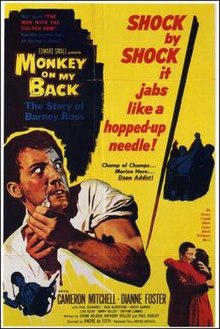
Laudanum is a tincture of opium containing approximately 10% powdered opium by weight. Laudanum is prepared by dissolving extracts from the opium poppy in alcohol (ethanol).

Barney Ross was an American professional boxer. Ross became a world champion in three weight divisions and was a decorated veteran of World War II. In his time, he was known as the Pride of the Ghetto.

The Man with the Golden Arm is a 1955 American drama film noir directed by Otto Preminger, based on the novel of the same name by Nelson Algren. Starring Frank Sinatra, Eleanor Parker, Kim Novak, Arnold Stang and Darren McGavin, it recounts the story of a drug addict who gets clean while in prison, but struggles to stay that way in the outside world. Although the addictive drug is never identified in the film, according to the American Film Institute "most contemporary and modern sources assume that it is heroin", although in Algren's book it is morphine. The film's initial release was controversial for its treatment of the then-taboo subject of drug addiction.

A Hatful of Rain is a 1957 American drama film about a young married man with a secret morphine addiction, based on a 1955 Broadway play of the same name. It is a medically and sociologically accurate account of the effects of morphine on an addict and his family. The frank depiction of drug addiction in a feature film was a rarity for its time.
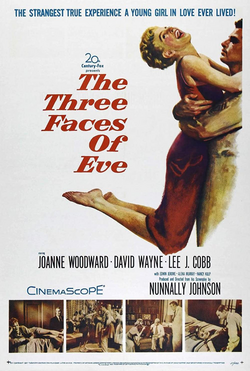
The Three Faces of Eve is a 1957 American film noir mystery drama film presented in CinemaScope, based on the book of the same name about the life of Chris Costner Sizemore, which was written by psychiatrists Corbett H. Thigpen and Hervey M. Cleckley, who also helped write the screenplay. Sizemore, also known as Eve White, was a woman they suggested might have dissociative identity disorder. Sizemore's identity was concealed in interviews about this film and was not revealed to the public until 1977. The film was directed by Nunnally Johnson.
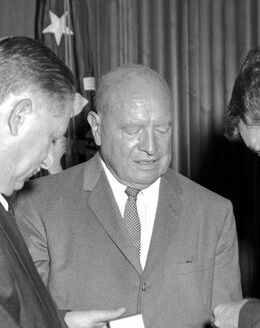
Harry Jacob Anslinger was an American government official who served as the first commissioner of the U.S. Treasury Department's Federal Bureau of Narcotics during the presidencies of Herbert Hoover, Franklin D. Roosevelt, Harry S. Truman, Dwight D. Eisenhower, and John F. Kennedy. He was a supporter of Prohibition, and of the criminalization of all drugs, and spearheaded anti-drug policy campaigns.

Francis Bosley Crowther Jr. was an American journalist, writer, and film critic for The New York Times for 27 years. His work helped shape the careers of many actors, directors and screenwriters, though his reviews were criticized as unnecessarily harsh. Crowther was an advocate of foreign-language films in the 1950s and 1960s, particularly those of Roberto Rossellini, Vittorio De Sica, Ingmar Bergman, and Federico Fellini.
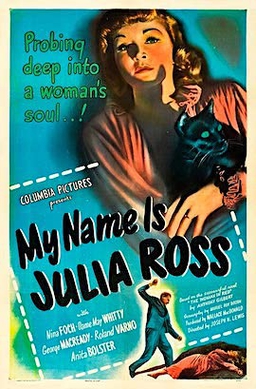
My Name Is Julia Ross is a 1945 American gothic film noir directed by Joseph H. Lewis, and starring Nina Foch, Dame May Whitty, and George Macready. Its plot follows a young woman in England who is hired as a live-in secretary for an ailing widow, where she awakens one day and is gaslit by those around her, claiming she is someone else. The screenplay is based on the 1941 novel The Woman in Red by Anthony Gilbert. The film received a loose remake called Dead of Winter (1987), starring Mary Steenburgen.

Ship Ahoy is a 1942 American musical-comedy film directed by Edward Buzzell and starring Eleanor Powell and Red Skelton. It was produced by MGM.

Raintree County is a 1957 American epic historical romance western film adapted from the 1948 novel of the same name by Ross Lockridge Jr. The film was directed by Edward Dmytryk and distributed by Metro-Goldwyn-Mayer. Set in the American South against the backdrop of the Antebellum South and the American Civil War, the film tells the story of a small-town Midwestern teacher and poet named John Shawnessy, who meets and marries a beautiful Southern belle named Susanna Drake; however, her emotional instability leads to the destruction of their marriage. The leading roles are played by Montgomery Clift, Elizabeth Taylor, Eva Marie Saint, Nigel Patrick and Lee Marvin.

Hell on Frisco Bay is a 1956 American CinemaScope film noir crime film directed by Frank Tuttle and starring Alan Ladd, Edward G. Robinson and Joanne Dru. It was made for Ladd's own production company, Jaguar.

Night Song is a 1948 American drama film directed by John Cromwell and starring Dana Andrews, Merle Oberon and Ethel Barrymore.

In Case of Adversity is a 1958 French crime film directed by Claude Autant-Lara and starring Jean Gabin, Brigitte Bardot and Edwige Feuillère. It was released as Love Is My Profession in the United States. It tells the story of a married lawyer who rigs a trial to acquit a young female criminal he has become obsessed with, even to the point of imagining they might have a life together and start a family. The screenplay was written by Jean Aurenche and Pierre Bost after the novel In Case of Emergency by Georges Simenon. The film was released in France on 17 September 1958.
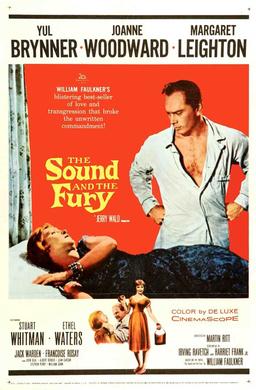
The Sound and the Fury is a 1959 American drama film directed by Martin Ritt. It is loosely based on the 1929 novel of the same title by William Faulkner.

Cry Terror! is a 1958 American crime thriller film starring James Mason, Inger Stevens, and Rod Steiger. The story was written and directed by Andrew L. Stone. Neville Brand, Jack Klugman and Angie Dickinson appear in support.

Istanbul is a 1957 American CinemaScope film noir crime film directed by Joseph Pevney, and starring Errol Flynn and Cornell Borchers. It is a remake of the film Singapore, with the location of the action moved to Turkey. The plot involves an American pilot who becomes mixed up with various criminal activities in Istanbul.

A Stranger in My Arms is a 1959 American CinemaScope drama film directed by Helmut Käutner and starring June Allyson, Jeff Chandler, Sandra Dee, Charles Coburn, Mary Astor and Peter Graves.
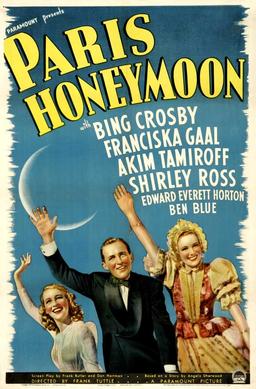
Paris Honeymoon is a 1939 American musical film directed by Frank Tuttle and written by Frank Butler and Don Hartman. The film stars Bing Crosby, Franciska Gaal, Akim Tamiroff, Shirley Ross, Edward Everett Horton and Ben Blue. Filming took place in Hollywood from May 23 to July 1938 and the film was released on January 27, 1939, by Paramount Pictures.

He's a Cockeyed Wonder is a 1950 American comedy film directed by Peter Godfrey and written by Jack Henley. The film stars Mickey Rooney, Terry Moore, William Demarest, Charles Arnt, Ross Ford and Ned Glass. The film was released on December 2, 1950, by Columbia Pictures.
The Boylan Act was a piece of April 1914 legislation in New York State, dealing with narcotics and addiction. The Act predated the federal 1915 Harrison Act, and in some ways anticipated it. Charles B. Towns, one of the sponsors of the Act, stated "it takes only five or six days to cure a drug fiend in hospital."
